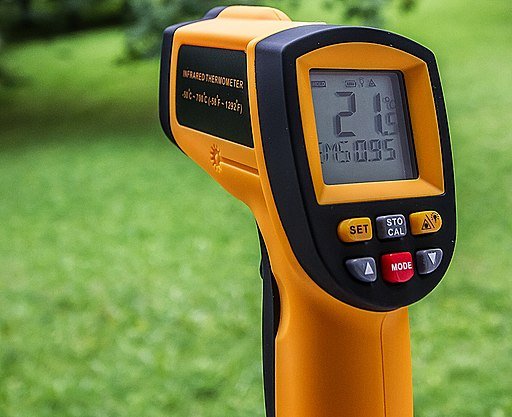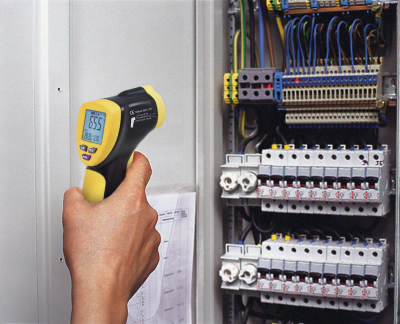Pyrometer - Non Contact Temperature Measurement
Introduction
Hello, and welcome back. In a prior post I described heat energy versus temperature, and how to measure temperature by contact methods. While a contact sensor is impacted by all forms of heat transfer, conduction is the primary method impacting the contact type of sensor. Temperature can also be measured by the amount of heat energy that is radiated without making contact. Think of a metal that heats up and glows red. All materials emit electromagnetic radiation in the visible and infrared (IR) spectrum that is proportional to thermal energy.

By Թագուհի Սաղաթելյան CC BY-SA 4.0
A pyrometer is a type of remote sensing thermometer used to measure the surface temperature based on the amount of thermal radiation. Various forms of pyrometers have historically existed. In the modern usage, it is a device that determines the surface temperature of a material at a distance based on the spectrum of the thermal radiation it emits.
Emissivity
Pyrometers are IR temperature sensors that use a setting called emissivity to relate IR energy to temperature. Emissivity is determined by a materials ability to radiate heat energy relative to a black body, and is given as a constant between 0 and 1. An ideal black body emits thermal radiation at around 448Watts per square meter at 25C, and materials are rated on how they compare.
For example a black surface will emit better than a white surface. Keep in mind that ideal back bodies absorb all light such that only the heat energy is being emitted. White objects reflect light along with the heat emission reducing the heat signature. Shiny reflective surfaces are even lower in emissivity because of this property. Metals like gold and silver can be more difficult to measure because of their low emissivity.

By Hedwig Storch CC BY-SA 3.0
Advantages of Non Contact Measurement
Temperature is one of the most common quantities measured, second only to time. While the contact methods mention in the prior post are effective, there are many advantages to non contact temperature measurement.
Speed: The IR detectors respond to the light energy in fractions of a second (mili-seconds typical), and do not require conduction to transfer energy.
Moving Targets: Materials moving on a conveyor belt can be measured without contact.
Hazardous Environments: The temperature of hazardous and physically inaccessible objects like high voltage components can be measured at a safe distance.
High Temperatures: The contact methods cannot handle environments above 1300°C, but using the emitted IR energy allows measuring temperature in excess of 1300°C without issue.
Non Invasive In most cases measuring a quantity causes a change in the quantity. However using emitted IR energy for temperature allows the temperature to be measured without any impact. In other words using a pyrometer prevents any loss of energy from making a measurement.
For example IR pyrometers are used in furnaces because of both the high temperature and lack of accessibility. A pyrometer, also called a radiation thermometer, is used to monitor the temperature of items that are changing phases from liquid to solid. This can be as simple as monitoring the temperature of a varnish drying without scratching the surface.

By Trotec-gmbh Public domain
Considerations
The detector is defined as the measurement device and the target is the device under test. Special considerations are required when measuring targets that have background energy that interfere with the thermal signature. For example if the target is much cooler than the background, the background must be insulated. Other considerations involve the medium between the detector and the target. For example particles like dust should be filtered as not to obstruct the signature of the target.
IR energy is not one fixed wavelength, and there are detectors available that focus on two or more wavelengths. The science of thermal radiation is responsible for the development of pyrometry.
Conclusion
The scope of this post is to communicate how pyrometers measure temperature based on the IR energy that is emitted because of heat. A key term mentioned is emissivity, in that the target being measured is emitting the heat signature. For example some IR detectors have laser pointers, and it is important to note the laser pointer is not making the measurement. The measurement is form the thermal energy being emitted, and the pointer is used to position the instrument.
Sources
State of website as of February 2018:
https://en.wikipedia.org/wiki/Pyrometer
https://en.wikipedia.org/wiki/Emissivity
http://support.fluke.com/raytek-sales/Download/Asset/IR_THEORY_55514_ENG_REVB_LR.PDF
https://www.omega.com/literature/transactions/volume1/thermometers1.html
Thanks for taking the time to read. Your comments and suggestions are welcome! --3D
Being A SteemStem Member
Cool article. I love infra red sensors. Once we did a line follower with ir sensors. And at time we were in short of ir led. You know what we did. We used a red led. It worked!!
Interesting the regular LED would emit enough IR to function but it makes sense. Also makes me wonder if the IR detector might respond to some visible light too. ...probably a little of both, but more of LED emitting IR.
I have used IR LEDs and detectors, and they can be hard to troubleshoot as you cannot see the IR LED. However most cell phones do not have an IR filter, so you can use the camera on the smartphone to detect if the IR emitter LED is working.
--Thanks for the reply! --3D
get free upvote your post http://mysteemup.club
You have been scouted by @promo-mentors. We are always on the look out for promising authors.
I would like to invite you to our discord group https://discord.gg/vDPAFqb.
When you are there send me a message if you get lost! (My Discord name is the same as the one here)
Congratulations @three-d! You received a personal award!
Click here to view your Board
Do not miss the last post from @steemitboard:
Congratulations @three-d! You received a personal award!
You can view your badges on your Steem Board and compare to others on the Steem Ranking
Vote for @Steemitboard as a witness to get one more award and increased upvotes!